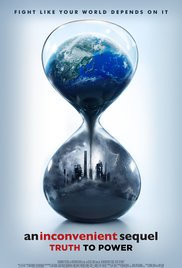
AN INCONVENIENT EQUAL: TRUTH TO POWER
US, 2017, 98 minutes, Colour.
Al Gore.
Directed by Bonni Cohen, John Shenk.
Al Gore has made his mark on American society. Serving for six years as vice president to Bill Clinton, he then stood for the presidency, losing in a decision from the Supreme Court of America to George W. Bush.
In not becoming president of the US, Gore was able to devote his time to environmental causes which he was always interested in (with scenes from his presence at international meetings from the 1980s). And he was able to appear in the documentary, An Inconvenient Truth, which won the Oscar for Best Documentary of 2006. His name became commonplace with environmentalists as well as politicians, whether believers in climate change or sceptics. After the film, he set up an institute for environmentalist trainees with candidates from all over the world, able to contribute to the environmental discussions and influence political decisions. A number of scenes show participants and his workshops, listing the variety of countries from which they came.
A decade later, a sequel, with some tones of desperation about what has happened and what has not happened since 2006 – but, some optimism about the increasing consciousness throughout the world, the serious look at disasters in the last 10 years, developments in such countries as India, and the 2015 Paris agreement. (There are many downbeat moments towards the end of the film with Donald Trump’s campaign, his election as American president, his anti-environment advisers, his withdrawal from the Paris agreement.)
But, something can and must be done. Learning more of the truth leads to an effective exercise of power as the subtitle suggests.
As might be expected, the visuals are often very impressive. This is particularly true of disaster sequences, floodwaters in the streets of Miami, the devastation of hurricanes in the Philippines, the contrast between floods, drought, the reality of evaporation and the weakening of soil and its consequences for farming and food producing.
The film ranges around the world as might be expected. Al Gore has many contacts. His visit to India and discussions with the authorities there, their choices concerning coal, their comments about being where the United States was 150 years earlier and the needs of people for energy and electricity, seems to offer something of an impasse, even in Paris. However, the film shows Gore contacting a businessman with an interest in renewables and the making of a deal concerning loans and interest rates with the Indian government – and final view of extensive solar panels in India.
Al Gore is a genial speaker, connects with an audience, is enthusiastic, sometimes impassioned. And he uses power points and video clips to great effect – as does the film.
Which means that the film is something of a visual lecture, an inspirational movie, a challenging documentary.
The environmental movement has developed over the decades but there are still many who are sceptics, have political and/or business interests, or even religious arguments about climate change.
But, for believers as well as sceptics, there is still the enormous human responsibility to control carbon emissions, for recycling, not wasting, and a growing consciousness for the preservation and health of the world – and for those who will inherit it in the future.